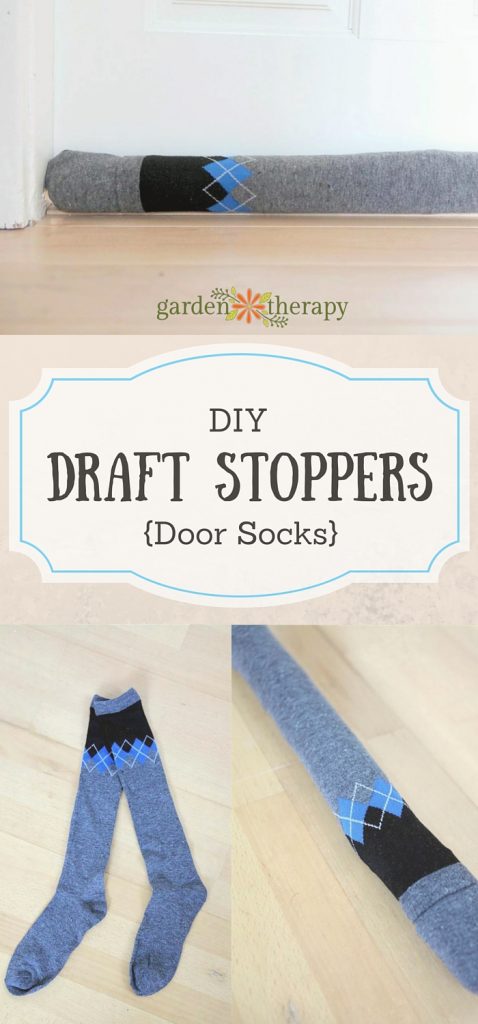The temperature is starting to dip down to where I think about nestling in front of the fireplace. The doors to the garden are no longer left wide open and our living space is just a wee bit smaller now. The perfect time to think about all those ways to conserve energy is when we need it the most.
Last year I made some door socks or DIY draft stoppers for the cool air that would seep under the doors and make the floors so chilly. I’ve changed the socks a bit this year for a new look with some grey, black and blue argyle knee socks I found. Click the link for the full tutorial on how to make door socks if you are starting from scratch.
The other way I have been using the door socks is to stop small drafts from the windows. If I’m not in a room all the time I keep my blinds down to keep them insulated, but when I want to sit by the window with the blinds up, it’s nice to have this little extra stopping the drafts.

But with this small measure only comes small energy conservation. Andrew Lake over at Good Guys Heating was kind enough to send me a list of 14 more that are good reminder of how we can use less to have more (energy that is).
14 More Ways To Reduce Your Heating Costs
1. Replace your furnace or boiler. The single biggest thing you can do to reduce your heating costs is to install a new heating system. New high efficiency furnaces use up to 40% less energy than older models. However, they can be expensive (about $5000). Read on for some low-cost/ no cost ways to reduce your heating costs.
2. Turn down your themostat. This seems like the obvious way to reduce your heating costs. But it probably won’t save you as much as you think. According the American Council for an Energy-Efficient Economy, you will save about 3% for every degree you lower the setting.
3. Check your furnace filter often. A dirty filter makes your furnace’s fan work harder, and might even prevent your furnace from being able to transfer heat to the air in your ducts. Check it once a month, and replace it after a light layer of dust has accumulated.
4. Seal leaks around doors, vents, and windows. Caulking and weatherstripping tape can be bought inexpensively. In older homes DIY weatherstripping will typically reduce your heating costs by about 10% (professional weatherstripping can reduce costs by 20% or more in some cases). But be careful- sealing your home too tightly may result in stuffy air. Natural Resource’s Canada has an excellent guide on weatherstripping.
5. Lower the temperature setting on your water heater. But be careful: lowering the temperature below 60C/140F may allow harmful bacteria to multiply, and will also make less hot water available. You can also apply insulation to the hot water pipe coming out of the heater (however if you have a newer hot water tank it is probably insulated well enough that an insulation blanket won’t help much).
6. Do not run exhaust fans for too long. Some exhaust fans can remove all of the heat from a home in a few hours! Also, if you have a fireplace, close the damper when it is not in use.
7. If you have a ceiling fan, set the speed to “slow” and the direction to “down”. Running your fan too fast will quickly remove the hot air radiating off your body, and make you feel cooler. But by setting it to blow the air downwards at a slow rate, it will move the hot air from where it collects near the ceiling down to the lower part of the room where the occupants are usually sitting down. A variable speed furnace can accomplish the same task by providing a slow, consistent flow of air while using little electricity.
8. Use personal heaters. You can place electric heaters in the most frequently occupied rooms, and use your furnace to keep the rest of your house at a lower temperature. But be careful not to let your house get too cold, or else your pipes might freeze. However, you can install heat tape (which contains an electric wire that will heat up the pipe when you plug it in) to prevent this.
9. Get a programmable thermostat. If you have a regular weekly routine, such as working during the day on Monday to Friday and staying home on weekends, a programmable thermostat will be able to automatically lower the temperature setting when you are not at home.
10. Add insulation to your attic. Canadian homes should have at least a foot of insulation in the attic. If you don’t, this can be a relatively inexpensive DIY project with a big payback.
11. Apply heat-reflecting film to your windows. This is much cheaper than installing new windows, but will make them a bit less clear.
12. Open the oven after cooking. Leaving the oven open a crack after cooking will let the hot air escape into the home, rather than up the chimney.
13. Close vents in rooms that are not used regularly. However, don’t close too many vents, as this will make it harder for the furnace to circulate air. Also make sure the vents are free of obstructions in rooms that are regularly used.
14. Close blinds and curtains at night. This will prevent heat from escaping out the windows.
So before you crank up the thermostat, think about what you can make or renovate to prevent the energy loss in the first place.




I made my wreath with orange boas and the crows stood out magnificently!
Well now, isn’t that smart! What a brilliant idea!